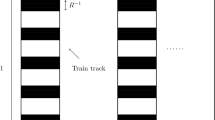Abstract
A rectangleA and a setS ofn points inA are given. We present a new simple algorithm for the so-called largest empty rectangle problem, i.e., the problem of finding a maximum area rectangle contained inA and not containing any point ofS in its interior. The computational complexity of the presented algorithm isO(n logn + s), where s is the number of possible restricted rectangles considered. Moreover, the expected performance isO(n · logn).
Similar content being viewed by others
References
M. J. Atallah and G. N. Frederickson, A note on finding a maximum empty rectangle,Discrete Applied Mathematics,13 (1986), 87–91.
B. Chazelle, R. F. Drysdale, and D. T. Lee, Computing the largest empty rectangle,SIAM Journal of Computing,15 (1986), 300–315.
A. Namaad, W. L. Hsu, and D. T. Lee, On the maximum empty rectangle problem,Applied Discrete Mathematics,8 (1984), 267–277.
G. T. Toussaint and D. Avis, On a convex hull algorithm for polygons and its applications to triangulation problems,Pattern Recognition,15 (1982), 23–29.
Author information
Authors and Affiliations
Additional information
Communicated by D. T. Lee.
Rights and permissions
About this article
Cite this article
Orlowski, M. A new algorithm for the largest empty rectangle problem. Algorithmica 5, 65–73 (1990). https://doi.org/10.1007/BF01840377
Received:
Revised:
Issue Date:
DOI: https://doi.org/10.1007/BF01840377




